Fowler A. Mathematical Geoscience
Подождите немного. Документ загружается.

540 9 Magma Transport
physical problem of how magma is transported to the Earth’s surface, but it is wise
to be aware of the underlying geochemical complexity.
Within the igneous rocks, the primary distinction lies in the silica content. Rocks
with high (70%) silica content are called acid, and the principal such rock is granite.
Rocks with low (50% ) silica are called basic, and the principal type is basalt. Below
this simple description, there are many, many further layers of sub-division.
Silica content has two major effects on physical properties. First, the viscosity
of silicic magma is typically much higher than that of basalt. Typical values for
basalt are 10
2
Pa s, while for rhyolite (the term refers to siliceous magma) it may be
10
5
Pa s, or higher. Thus rhyolite is hard to move. Second, the melting temperature
of basalt is generally higher. The result of this is that when mantle rocks melt, they
differentiate, and to a large extent, the different observed compositions of surface
rocks reflect their different thermochemical histories during melting.
9.1 The Magmatic Cycle
Just as there is a hydrological cycle and a carbon cycle in the Earth, so there is
a magmatic cycle. The magmatic cycle is bound up with the convection of the
Earth’s mantle, discussed in Chap. 8. The upwelling parts of the mantle circula-
tion are of two types: the oceanic ridges are associated with the upwelling parts of
essentially two-dimensional convection cells, while hot spots such as Hawaii are as-
sociated with isolated convective mantle plumes, which most probably originate at
the core-mantle thermal boundary layer. Both of these features cause partial melting
of the mantle, because of the excess heat and depressurisation associated with the
upwelling. The depressurisation is the more important of the two, as the precepts
of variable viscosity convection tell us that likely excess temperatures in plumes or
upwellings are of the order of 100 K. A third origin for magma is behind subduction
zones, where the frictional heat associated with the motion of the subducting slab
causes partial melting of the mantle.
The magma thus generated flows upwards under its own buoyancy. It percolates
through the asthenosphere, trickling as in a porous medium, and then collecting into
rivulets and channels which allow the flow of magma through the lithosphere to-
wards the continental crust. The buoyant driving force for the magma flow is the
density difference between the liquid and the surrounding country rock. The conti-
nental crust is much lighter than the underlying mantle, and so the situation com-
monly occurs that the liquid reaches a level of neutral buoyancy, beyond which it
cannot rise. At this point, which may be kilometres deep in the crust, the magma
may spread out in horizontal sills, and in so doing it may uplift or melt the over-
lying crustal rocks to form lopoliths or laccoliths, large magma chambers tens of
kilometres in extent, which then subsequently cool and crystallise over hundreds of
thousands of years. Subsequent erosion of the overlying rocks has exposed examples
of such igneous intrusions at the Earth’s surface. A particularly dramatic example is
that of the huge granite batholiths, which can be even larger.
9.1 The Magmatic Cycle 541
This description is slightly misleading. The propagation upwards of magma in
vertical conduits, or dykes, is accommodated by the extension of the dykes as open-
ing fractures. While it is indeed the buoyancy which drives this upwards motion, and
the accompanying fluid flow, the continuing propagation of the fracture requires the
fracture toughness at the crack tip to be exceeded. One way upwards motion can be
halted is by the arrival of the crack tip at a compositional unconformity, when the
weakness of the unconformity may allow preferential propagation sideways to form
a laccolith.
While it is possible for magma chambers to cool without further ado, it is fre-
quently the case that continued filling of the chamber leads to fracture of the overly-
ing crust, and consequent release of the magma at the surface. This is the mechanism
of volcanic eruption. Volcanic eruptions occur in a number of different ways, and
are described in Sect. 9.7. They are in essence periodic phenomena, being driven by
the continual replenishment of the magma chamber and its consequent pressurisa-
tion, and the periodic depressurisation caused by eruptive release. The periodicity is
driven by the freezing of the magma in the conduit to the surface between eruptions.
The eruptive style itself is extremely variable, ranging from the relatively mild
and relatively continuous Strombolian and Hawaiian eruptions, to the explosive
Plinian eruptions. The essential difference between eruptive styles is largely asso-
ciated with the viscosity of the magma, and also its volatile content. As one might
expect, larger volume flows are associated with larger periods between eruptions,
and these can lead to very extensive lava flows.
In the geological past, there have been occasional episodes during which truly
massive flood basalt eruptions have occurred. One such episode occurred some
66 My (million years) ago, and caused the formation of the kilometre thick Dec-
can Traps in India. These and other such massive eruptions have been associated
with major extinctions of biota, through the effect on climate of the effused ash and
gases in the atmosphere. In particular, the formation of the Deccan Traps occurs at
much the same time as the final extinction of the dinosaurs. It is thought that such
massive eruptive sequences may be associated with the arrival below the lithosphere
of mantle ‘super-plumes’. Such plumes would be likely to occur following founder-
ing of subducted lithosphere at the core-mantle boundary, in a way similar to that
describing the supposed style of episodic re-surfacing on Venus (Sect. 8.7).
The magmatic cycle is closed in disparate ways. Exsolution of gases such as wa-
ter vapour and carbon dioxide to the atmosphere return to the surface via rainfall,
reacting to form carbonate rocks for example. Ultimately, weathering and sediment
transport returns these substances to the ocean, and the resulting sediments are sub-
ducted back into the Earth’s mantle.
Not all magmatic products are returned, however. Magma forms by partial melt-
ing of mantle rocks in the asthenosphere. The so-called incompatible elements are
those which are melted first, and thus melting and subsequent eruption causes a
differentiation of the mantle composition. Additionally, the earlier melting compo-
nents are lighter than the residue, and thus when erupted and crystallised, they form
a lighter crust which remains at the surface. This, in fact, is how the continents
were formed, and why they remain perched—floating, really—at the surface of the
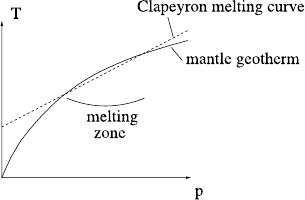
542 9 Magma Transport
mantle. Although oceanic products of volcanism are returned directly at subduction
zones, the products of continental volcanism are only slowly returned by weather-
ing, and there is a long term continuing chemical differentiation of the mantle taking
place.
9.2 Mechanisms of Magma Ascent
The basic physical problem which confronts us in igneous petrology is that of under-
standing why volcanoes occur at all; how does molten rock find itself at the Earth’s
surface, where the ambient temperature is about 300 K, far below the melting tem-
perature of any mantle or crustal rock? Indeed, why does the mostly solid mantle
melt at all?
The answer to this has two ingredients. The first is the circulation of the Earth’s
mantle. Mantle convection causes rock to rise beneath mid-ocean ridges, and also in
isolated locations (hot spots) due to thermal plumes, such as at Hawaii and Iceland.
Recirculation is associated with the subduction of oceanic lithosphere at oceanic
trenches. In regions of upwelling, the mantle rocks are relatively hot. In subduction
zones, the mantle rocks are wet (through their reaction with sea-water).
The second ingredient is the Clapeyron relation between melting temperature
and pressure. The melting temperature of mantle rocks increases steeply as pres-
sure increases. The effect of this is the following: under Hawaii, for example, the
hot upwelling mantle cools adiabatically as it rises; but the melting temperature de-
creases more steeply with pressure, and thus melting can occur through the effect of
decompression, as illustrated in Fig. 9.1.
Partial melting occurs as the rock rises, and it is usually thought that the melt
fraction is no more than a few per cent. Partial (and not complete) melting occurs
because the effective heat is supplied volumetrically—there is nothing to force a
jump in heat flux, such as would be necessary to melt rock completely.
Melting is also associated with subduction zones, although the reasons are less
clear. Volcanoes occur behind subduction zones (the Andes being a prime example),
and the volcanism is presumably associated with the subducting lithospheric slab.
Dehydration reactions in the slab as temperature and pressure increase may allow
diffusion of water into the surrounding mantle rock, which has the effect of dramat-
ically lowering its melting temperature. Partial melting may occur for this reason,
but the nature of progress of the magma to the Earth’s surface is enigmatic.
Fig. 9.1 Melting occurs
when the pressure melting
temperature lies below the
mantle geotherm
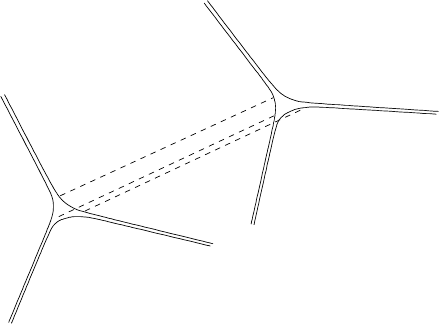
9.2 Mechanisms of Magma Ascent 543
Fig. 9.2 Three-grain junctions form a connected network
Partial melting because of decompression occurs at depths of about 100 km, but
it can be seen from Fig. 9.1 that the melt would typically refreeze a good way below
the surface. How then does it get to the surface? The answer to this has two stages.
For thermodynamic reasons, melt is first formed at four grain intersections, and then
spreads along three-grain junctions as indicated in Fig. 9.2. These junctions form a
connected tubular network, which allows the lighter melt to drain upwards through
the now porous rock matrix.
A model describing how this melt transport occurs in the asthenosphere is de-
scribed in Sect. 9.4. However, porous melt flow is unable to deliver magma to the
Earth’s surface (because the melt would simply freeze on to the base of the litho-
sphere, a process called underplating). In fact, we know that magma is supplied to
magma chambers within the Earth’s crust through cracks or fissures called dikes;
we know this because erosion allows old basaltic dikes to be observed. They typi-
cally have widths of the order of a metre. In Sect. 9.5, we provide a model which
describes the resulting rapid ascent of magma from an asthenospheric source region.
These parts of the story are relatively coherent. It is less clear how the conversion
from porous medium flow to crack hydraulic flow takes place, and also how magma
chambers are formed, but we will offer some thoughts on those processes too.
The process of mantle convection with partial melting allows us to explain the
formation of the crust and the continents. An initially homogeneous mantle will
become differentiated when it melts, because of the characteristics of melting and
solidification for multi-component materials. The description of these characteris-
tics is the domain of geochemistry, and we need to provide the rudiments of such a
description in order to be able to discuss such issues as the problems of continent
formation, or the emplacement of granite batholiths. It is also important to do so, be-
cause geochemical observations (for example, of differing chemical characteristics
of mid-ocean ridge basalt (MORB) and ocean island basalts (OIB)) have been used
to infer geodynamical constraints on the nature of mantle convection; mostly, these

544 9 Magma Transport
Table 9.1 Approximate compositions (weight per cent) of common igneous rocks
SiO
2
Al
2
O
3
Fe
2
O
3
/FeO MgO CaO Na
2
O/K
2
O
Granite 74 14 2 <119
Granodiorite 67 16 4 2 4 7
Quartz diorite 66 16 5 2 5 5
Andesite 58 17 7 3 7 5
Tholeiitic basalt 51 14 12 6 10 3
Olivine basalt 48 12 12 14 9 2
Peridotite 44 4 12 34 3 1
inferences ignore the important physical processes involved in melt generation and
emplacement.
9.3 Phase Diagrams and Geochemistry
The subject of igneous petrology—the geochemical classification of different
rocks—is one of fundamental difficulty, particularly for applied mathematicians.
Our drive is to consider the simplest models of reality, but the petrologist’s ambition
is to draw ever more excruciating distinctions between rock types, on the basis of
variations in chemistry, pressure, solid-state phase, texture, grain size, and so on. To
quote Krauskopf and Bird (1995), “the resulting long catalogue of names ...contin-
ues to appal beginners in petrology”. Thus the present description will be as simple
as possible, although it will appear to be complicated enough.
Rocks are composed of grains of different minerals, which are themselves formed
of various oxides. The composition of the Earth or of the crust is sometimes written
as percentages of these oxides, or of the mineral assemblages. Table 9.1 shows a
condensed version of oxide compositions; Fig. 9.3 shows a breakdown by mineral
of the composition of the commoner types of igneous rocks. In keeping with the
petrologist’s need for complexity, the liquid form (magma) of a rock has a different
name from its solid form: rhyolite is liquid granite, for example. Note also that
rock types are composed of different minerals: thus granite is composed of feldspar,
quartz and plagioclase, and varying minor amounts of other minerals.
The principal observation to take away from Table 9.1 is that the rocks show a
more or less linear trend in composition. The acid rocks (granite, granodiorite) have
high silica (SiO
2
) content, while the basic rocks (olivine, peridotite) are silica poor.
So the very simplest description of geochemistry would associate rock type with
silica content.
In fact, Table 9.1 shows that this linear trend is more or less reflected in other
oxides. As silica content decreases, iron and magnesium content increases (and so
Mg/Fe rich magmas are called mafic, while silica-rich magmas are called felsic);
aluminium stays the same, calcium increases, sodium and potassium decrease. Only
peridotite replaces some aluminium and calcium with magnesium.
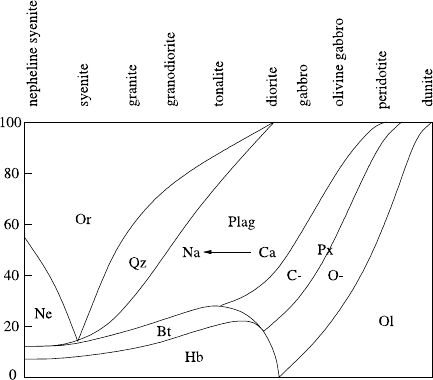
9.3 Phase Diagrams and Geochemistry 545
Fig. 9.3 Mineralogical
composition (per cent by
volume) of igneous rocks
(after Mason and Moore
1982, p. 96). Minerals are
nepheline (Ne), orthoclase
(Or), quartz (Qz), biotite (Bt),
hornblende (Hb), plagioclase
(sodic (Na) to calcic (Ca)),
pyroxene (Px), including
clinopyroxene (Cpx, denoted
C–) and orthopyroxene (Opx,
denoted O–), and olivine (Ol)
Figure 9.3 shows that this linear trend is more or less reflected in a replacement of
minerals as silica content increases: olivine → pyroxene → plagioclase → quartz,
K-feldspar, and the important point is that this sequence more or less reflects the
sequence in which minerals crystallise from a magma as the temperature is reduced.
(Although our concern in this chapter is with melting, it is normal to discuss phase
changes from the point of view of crystallisation, and we shall do so, reversing our
stance later on.)
A more realistic description of the crystallisation process as temperature is re-
duced is Bowen’s reaction series:
Ol →Px →Hb →Bt
Ca–Plag →Na–Plag
[→Qz, Fs]. (9.1)
The abbreviations represent the discontinuous reaction series olivine → pyroxene
→ hornblende → biotite, and the continuous series calcium plagioclase → sodium
plagioclase. The mafic minerals of the discontinuous series are formed in turn, each
crystallised phase reacting with the melt to form the next phase, while those of
the continuous series are formed continually from the melt (with less calcium as
crystallisation proceeds). Typically both phases (and perhaps others also) may be
crystallising at the same time.
It can be seen from Table 9.2 that density also decreases essentially uniformly as
silica content increases.
9.3.1 Phase Diagrams
Apart from all the names, the story so far seems relatively simple; but, there is a lot
of detail. We begin by describing the use of phase diagrams.

546 9 Magma Transport
Table 9.2 Density of mineral
phases
Mineral Density (gm cm
−3
)
K-feldspar 2.6
Quartz 2.65
Plagioclase ∼2.7
Pyroxene ∼3.5
Olivine ∼3.8
Nepheline 2.6
Biotite 3.0
Hornblende 3.2
Plagioclase is a solid solution of albite (Ab) with anorthite (An). The chemical
formulae for these two ‘end-members’ are
Ab =NaAlSi
3
O
8
,
An =CaAl
2
Si
2
O
8
;
(9.2)
so Ab is ‘sodium plagioclase’ and An is ‘calcium plagioclase’. To say that a solid
solution exists means that in the crystal structure of the solid, atomic replacement
may occur: NaSi in Ab can simply replace CaAl in An. Thus, in general, we can have
any formula intermediate between the two, thus a general formula for the solution
is
plag =(NaSi, CaAl)AlSi
2
O
8
=Na
x
Ca
1−x
Al
2−x
Si
2+x
O
8
, (9.3)
which represents the fact (in the first formula) that CaAl can replace NaSi, or in the
second that we have a fraction x of Ab, and a fraction 1 −x of An. Often one writes
An
40
to represent a composition of 40% An, 60% Ab, as in Table 9.3.
Table 9.3 Approximate compositions (weight per cent) of common minerals
Mineral SiO
2
Al
2
O
3
Fe
2
O
3
/FeO MgO CaO Na
2
O/K
2
O
Nepheline 44 32 < 10< 121
Hornblende 45 11 16 10 12 2
Biotite 37 17 21 9 < 19
Pyroxene (e.g., hypersthene) 53 3 18 23 2 < 1
Orthoclase 64 19 < 1–< 115
Quartz 100 – – – – –
Plagioclase
An
20
An
80
63 23 – – 4 10
48 33 – – 16 2
Olivine
Fo
96
Fo
3
41 < 14 54––
30 < 165 12–
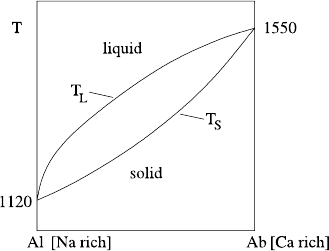
9.3 Phase Diagrams and Geochemistry 547
Fig. 9.4 Solid solution of the
plagioclase system, between
the end members albite
(Al-sodium plagioclase) and
anorthite (An-calcium
plagioclase). Melting
temperatures shown in
degrees Celsius
Pure An and pure Ab have different melting points, and for a composition of
the two substances, there is no longer a single melting temperature, but a solidus
and a liquidus. The solidus is the temperature at which melting of a solid begins,
and the liquidus is where crystallisation of a liquid begins. The two temperatures
are not equal, and for a solid solution such as Ab–An, the corresponding phase
diagram is as shown in Fig. 9.4. This is an equilibrium diagram. For temperatures
T greater than the liquidus T
L
, only liquid can occur. On the liquidus, liquid can
be in equilibrium with solid, but the compositions of solid and liquid are different.
At a fixed temperature, the liquid composition is that of the liquidus, but the solid
composition is that of the solidus.
The phase diagram can tell us why plagioclase crystallisation becomes more
sodium-rich as it proceeds. Consulting Fig. 9.4, we see that when plagioclase crys-
tallises, the resulting solid is enriched in calcium. As crystallisation proceeds, the
residual melt therefore becomes enriched in sodium, and continued crystallisation
requires decreasing temperatures, so that the crystals become increasingly sodium-
rich. As cooling proceeds, the melt composition travels, in temperature-composition
space, down the liquidus.
Plagioclase is one of the feldspar group of minerals, of which the other member is
orthoclase, or simply K-feldspar, which substitutes potassium for sodium/calcium.
Thus orthoclase is
Or =KAlSi
3
O
8
, (9.4)
formed from Ab by replacing Na with K. Ab and Or also form a solid solution,
but not at high water pressure. Figure 9.5 shows the resulting typical phase diagram
which occurs in this case. The liquidus and solidus curves have the same interpreta-
tion, but now there is a eutectic point E and a lower ‘solvus’ curve comprising the
two portions AA
and KK
. Suppose we cool a potassium-rich melt with composi-
tion to the right of E. On the liquidus, potassium-rich feldspar (KFs) is precipitated,
thus the residual melt is driven down the liquidus until it reaches E.AtE, separate
crystals co-exist stably within the solvus curves AA
and KK
. (The solvus curve
represents a solid-state unmixing curve; if solid KFs is cooled through KK
for ex-
ample, then the crystals become unstable, and further cooling separates the solid
into crystals of separate compositions on KK
and AA
, as indicated in Fig. 9.6.)
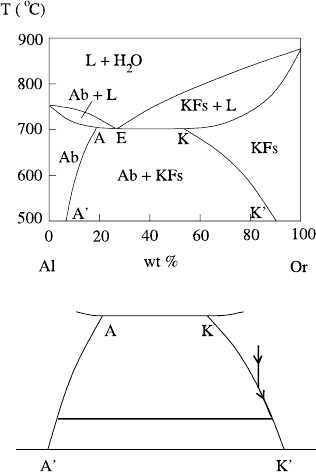
548 9 Magma Transport
Fig. 9.5 Water-saturated
phase diagram for albite
(Ab)-orthoclase (Or), after
Krauskopf and Bird (1995,
p. 455). The symbol KFs
denotes potassium feldspar
Fig. 9.6 Solid-state
unmixing of alkali feldspar
Figure 9.5 illustrates another important effect of water. Water is typically present
in rocks at a level of one per cent or less, but the presence of such quantities can
depress the liquidus temperatures by hundreds of degrees centigrade to the sorts of
temperatures (800–1100°C) which are commonly observed. In fact, the late stage
minerals of the discontinuous crystallisation series, hornblende (an amphibole) and
biotite (a mica) are specifically hydrous minerals which incorporate water.
9.3.2 Ternary Phase Diagrams
To extend our understanding of phase diagrams, we need now to consider how
a three-phase liquid crystallises. To be specific, we will consider how plagio-
clase interacts with pyroxene (px). Pyroxenes are characterised by the formula
[(Ca,Mg,Fe,Na,Al)SiO
3
]
2
, thus we have
diopside (Di) CaMgSi
2
O
6
,
enstatite (En) Mg
2
Si
2
O
6
,
hypersthene (Mg,Fe)
2
Si
2
O
6
,
augite Ca(Mg,Fe)Si
2
O
6
,
hedenbergite CaFeSi
2
O
6
,
jadeite NaAlSi
2
O
6
,
acmite NaFeSi
2
O
6
,
(9.5)
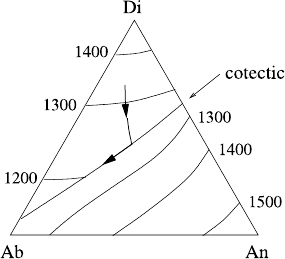
9.3 Phase Diagrams and Geochemistry 549
Fig. 9.7 Ternary phase
diagram for the system
Di–An–Ab
(diopside–anorthite–albite).
The isotherms are in degrees
centigrade. From the diopside
field, a cooling magma
evolves towards the cotectic
line, and then follows it
and so on. Augite is a solid solution of diopside and hedenbergite, and hypersthene
is a solid solution of enstatite and ferrosilite Fe
2
Si
2
O
6
. To be specific, we consider
the three-component system Di–An–Ab (diopside–anorthite–albite), the latter two
being the calcium-rich and sodium-rich plagioclases. In order to present the phase
diagram, we must represent the three compositions in two-space. This is done by
plotting compositions on an equilateral triangle, as shown in the ternary phase dia-
gram for Di–An–Ab (Fig. 9.7).
If we take the origin at the centre of the triangle, and denote the vertices by the
vectors D
i
, A
b
and A
n
(thus D
i
+A
b
+A
n
=0) then any point in the triangle can
be written uniquely in the form λD
i
+ μA
b
+ νA
n
, where λ + μ + ν = 1; then
λ,μ,ν represent the fractional composition of Di, Ab and An. Equivalently, λ is the
distance from the point to the line Ab–An, measured as a fraction of the altitude of
the triangle. Thus the vertices represent pure components, and the sides represent
two component mixtures.
Really, the phase diagram needs to have a temperature axis coming out of the
paper, so that liquidus and solidus surfaces are plotted. Usually one does not try
to do this. The temperatures of the liquidus surface are plotted as contours (as in
Fig. 9.7), and the solidus surface is suppressed entirely—because we are thinking
of crystallisation rather than melting. But one should study ternary phase diagrams
like Fig. 9.7 with the understanding that diagrams such as those in 9.4 or 9.5 are the
suppressed sideways-on view.
Ternary diagrams of three components all with solid solutions are featureless,
but also not very interesting. However, pyroxene and plagoclase do not form a solid
solution, and this is indicated by the cotectic line within the triangle, which is simply
the continuation in the three-component diagram of the eutectic points which exist
for Di–An and Di–Ab. If we take a slice through temperature-composition space
orthogonal to the composition triangle, we will see a phase diagram like Fig. 9.5,
and the eutectic point of Fig. 9.5 moves in composition space (becoming the cotectic
line) as we move from An to Ab.
We can now read the crystallisation history of a plagioclase-pyroxene melt. Sup-
pose that we start with a melt of 40% Di, 30% Ab, 30% An, which places us on
the diopside side of the cotectic. The liquidus temperature is about 1300°C, and
on reaching this we begin to crystallise diopside-rich crystals, because the solidus
